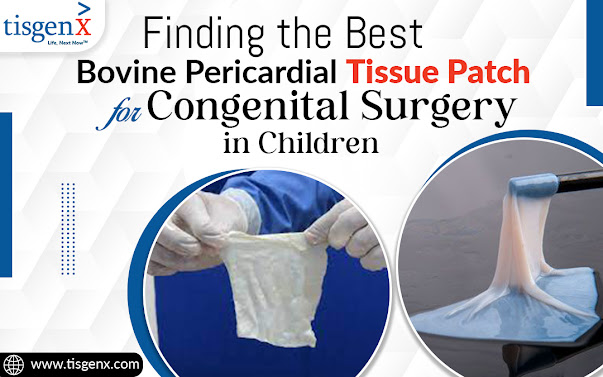Finding the Best Bovine Pericardial Tissue Patch for Congenital Surgery in Children
Paediatric
surgeons have come to rely on Bovine Pericardial Tissue Patch for congenital surgery as
a go-to for treating congenital abnormalities. Because of their exceptional
biocompatibility and longevity, these patches—originating from bovine
sources—are great for fixing structural defects. Careful assessment of
essential criteria, including tissue properties, processing procedures, and
clinical considerations, is necessary for selecting the best bovine pericardial
tissue patch for paediatric surgery.
Tissue Features:
Relationship with biocompatibility:
Biocompatibility
is paramount when choosing a bovine pericardial tissue patch for paediatric surgery.
Thoroughly evaluating the patch's compatibility is necessary to ensure it
blends in with the sensitive physiology of paediatric patients. Because
developing immune systems are so delicate, keeping side effects to a minimum,
especially in children, is essential.
By
carefully considering these factors, medical professionals can select a Bovine
Pericardial Tissue Patch for congenital surgery, improve
patient outcomes, and help with postoperative recovery, all while addressing
congenital anomalies.
Building Reliability:
An
essential factor in the success and durability of a bovine pericardial tissue
patch in paediatric surgery is how well it adapts to the changing anatomy of a
young child. To endure the intrinsic obstacles of growing physiology, choosing
patches with substantial structural integrity is vital.
Essential
evaluation criteria include tensile strength, elasticity, and resistance to
tearing, as these qualities affect the patch's long-term endurance of
physiological loads.
Methods for Sterilisation:
Choose
patches that undergo proven sterilization techniques to avoid the danger of
infections in paediatric patients. Standard methods that maintain tissue
integrity include gamma irradiation and ethylene oxide sterilization.
Methods for Processing:
Cellular depletion:
Decellularization
and crosslinking are essential factors affecting biocompatibility and long-term
functionality when choosing the best bovine pericardial tissue patch
for paediatric surgery. Complete decellularization is necessary
to reduce the likelihood of immunological responses in children. To remove
cellular components while maintaining the tissue's structural integrity,
choosing patches that will undergo careful procedures, such as detergent-based
or enzymatic methods, is essential. This promotes a balanced integration within
the delicate immune system of young children.
Treatments for Anti-Calcification:
To
avoid mineralization in the long run, apply anti-calcification chemicals to
patches first.
Particularly
in younger patients with longer life expectancies, assess how well these
therapies reduce the likelihood of calcification.
Meet All Requirements:
USDA Approved:
Before
selling patches, regulatory authorities like the US FDA approve them.
Ensure
that kid surgical devices follow all requirements.
Ensure Quality:
Selecting
a bovine
pericardial tissue patch for paediatric surgery requires
quality assurance to ensure patient safety and industry requirements. Choose
patches from reliable suppliers who prioritize quality control and assurance.
Reputable tissue manufacturers utilize rigorous processes to achieve high
quality and processing standards. This requires strict production and testing
requirements.
Clinical Factors:
Care during Surgery:
When
choosing a bovine pericardial tissue patch for a paediatric operation, surgical
handling factors are crucial, highlighting the need for accuracy and a firm
attachment. When it comes to paediatric procedures, which need extreme
accuracy, choosing patches that make them easy to handle is of the utmost
importance.
The capacity to conform:
The
patch must be flexible and conformable to anatomical features in paediatric
patients whose organs are smaller and more delicate. Assess the patch's
adaptability to surgical sites while maintaining its integrity.
Clinic Results:
Examine
clinical studies of bovine pericardial patches used in paediatric congenital
surgeries. Choose patches with good clinical outcomes, such as fewer side
effects and faster healing.
Conclusion:
Successful congenital procedures require the finest bovine pericardial tissue patch for paediatric surgery. Prioritise biocompatibility, structural integrity, and regulation to protect children. All tissue properties, processing methods, and therapeutic importance are at stake. Optimal decellularization, crosslinking, and anti-calcification therapy can prolong patch life in the paediatric physiological environment. For complete findings, combine clinical and surgical results. If you want to know more about this you must contact with Tisgenx.




Comments
Post a Comment